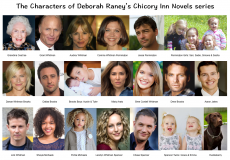by Deborah Raney
The fifth and final book in my Chicory Inn Novels series released recently, and I’m now working on the first book in a new series. Having written mostly stand-alone novels for most of my writing career, this has been an interesting experience and one I’ve learned so much from. First let’s look at the pros and cons of series books:
PROS:
- Once you’ve created your setting and any recurring characters, half your work for subsequent books in the series is done!
- If you’re an author who grows very attached to your characters and has a hard time saying “goodbye,” series let you stick around a while.
- Series let you develop characters more deeply and over a longer period of time than the average stand-alone.
- Readers love series (although be aware that some readers wait until an entire series is out before they start reading—or buying—the books.)
CONS:
- If you grow bored working with the same setting or characters, you might feel stuck long before your contract is fulfilled.
- If the first book of a series bombs, it can create a dilemma about how to proceed.
- With shrinking space on the bookshelf, bookstores often carry only an author’s newest book. This can make it difficult for customers to find an entire series at once. (Of course, they can always order online.)
- Committing to a series is committing to one publisher for a long period of time. You risk cancellation if an imprint closes, or a publishing house dissolves.
- If you write contemporary, it can be difficult to keep up with technology. The iPad your character used in Book One might be obsolete by the time you get to Book Five.
Here are some things I’ve learned through the writing of two two-book series, two three- book series, and my most recent five-book series that I’d like to pass along to anyone who might be considering proposing or writing a series.
TIPS:
- Be sure you have enough material for the number of books you’ve planned. It’s not unusual to have a grand, high-concept idea for Book One that fizzles out long before you reach Book Five.
- Consider making each book of the series a stand-alone that concludes sufficiently so that readers won’t be disappointed if they read Book Three first, or if they don’t like the series well enough to continue after a book or two. Readers are sometimes disgruntled if they invest time in Book One and then find they must read future books to discover the main characters’ happy ending.
- The books of a series might tie together in theme (weddings, royal families, stories of hope, etc.) and setting (each book is about a different character in the same small town, etc.) rather than being a continuation of the stories of one or two characters. (But realize that such a loose tie negates some of the pros mentioned above!)
- Create a “bible” with all the details of your characters, setting, and storylines. You might think you’ll remember, but trust me, you won’t!
- Keep an updated, ongoing timeline for each book andfor the entire series. Readers have sharp eyes when it comes to inconsistencies!
- Before you start, research what series are already being published, and work hard to make your series unique.
- Most publishers will want you to have an official series name that will likely appear on the book covers. Often this series title will hint at the setting or the theme of the series. It’s also helpful if individual titles in the series fit together well. (Think of Karen Kingsbury’s and Tamera Alexander’s series where all the titles in a series begin with the same letter of the alphabet. In my Chicory Inn series, each of the five titles has the word HOME in it, which also echoes a main theme of each book.)
- I’ve found it very helpful to have photo reference for the setting, each character, the homes where many scenes take place, etc. I use Pinterest and Scrivener to make “idea boards” with all those images. I also set my desktop with those inspiration photos so that I’m constantly, visuallyseeing my characters and setting.
- Consider creating a music soundtrack for your series. Music can be a powerful, positive trigger for getting you in the zone for writing about a specific setting or family of characters. I’ve done the same thing with scented candles, snacks, and even flowers, etc., surrounding myself with things that call to mind my story and help me go deep into my story world.
- Enjoy the privilege of living with beloved characters for longer than the time it takes to write just one book. It’s a pleasure to write “the end” knowing it’s really only the beginning of a new book with the same wonderful setting and/or cast of characters! (But prepare for the final goodbyes to be even more difficult than usual after you’ve lived with your characters for so long!)
 Deborah Raney’s first novel, A Vow to Cherish, inspired the World Wide Pictures film of the same title and launched Deb’s writing career. Twenty years and more than thirty books later, she’s still writing. She and her husband traded small-town life in Kansas––the setting of many of Deb’s novels––for life in the city of Wichita. They love traveling to visit four grown children and seven grandchildren who all live much too far away. Visit Deb on the Web at www.deborahraney.com.
Deborah Raney’s first novel, A Vow to Cherish, inspired the World Wide Pictures film of the same title and launched Deb’s writing career. Twenty years and more than thirty books later, she’s still writing. She and her husband traded small-town life in Kansas––the setting of many of Deb’s novels––for life in the city of Wichita. They love traveling to visit four grown children and seven grandchildren who all live much too far away. Visit Deb on the Web at www.deborahraney.com.



Comments 0
I love your suggestions for writing a series. Do you have advice for the length of each book? Should they all be the same or is it permissible to have a novella between novels?
Blessings to you and on your new series
Thank you for this excellent post! I’m currently writing a series and I especially like the idea of creating a soundtrack and keeping the photos of characters and scenes on my desktop. I love getting deep into a story world, both as a reader and a writer.
Thanks, Barbara and Angela, for your comments! As for length of the books, Barbara, my series novels are usually around 80-90,000 words. And I DO think it’s best for all the books to be close to the same length. Usually, a novella works best AFTER the entire series has been released…a chance for readers to see one more glimpse of characters they’ve come to love. But sometimes a novella sparks an idea for an entire series, in which case, it would come first. I don’t think I’ve ever seen a novella in the MIDDLE of a series, but I suppose it could work if you had a good reason for doing it that way. I’d just be extra careful that readers understood they were NOT getting a full-length novel. Even when I label my cover with “A NOVELLA” readers often express disappointment in the shorter length!
I’ve loved your books over the years and found your article most helpful. I am working on a series that has an island setting with the Community Church Pastor, a supporting character, tying the stories together. Many of your suggestions definitely apply. Thank you.
Excellent info, but Deb Raney is excellent as a teacher, writer and critique editor–so of course! 🙂 Well done Deb!
So glad you found this helpful, and thank you for reading my books, Claudette! And thank you so much for that encouraging word, Susan!
So much good information here! This would make a good workshop for a conference. Just sayin’! Hint! Hint!
Outstanding post, Deb! Thank you! I used many of your tips in creating my trilogy titled THE ITALIAN CHRONICLES.. Of special help was my playing a CD of Johann Sebastian Bach’s beautiful piece, IL SICILIANO, in the background as I wrote. Thank you again. This post is a keeper! 🙂
Blessings,
MaryAnn
_________________________________
MaryAnn Diorio, PhD, MFA
Author, Teacher & Writing Coach
http://www.maryanndiorio.com